History
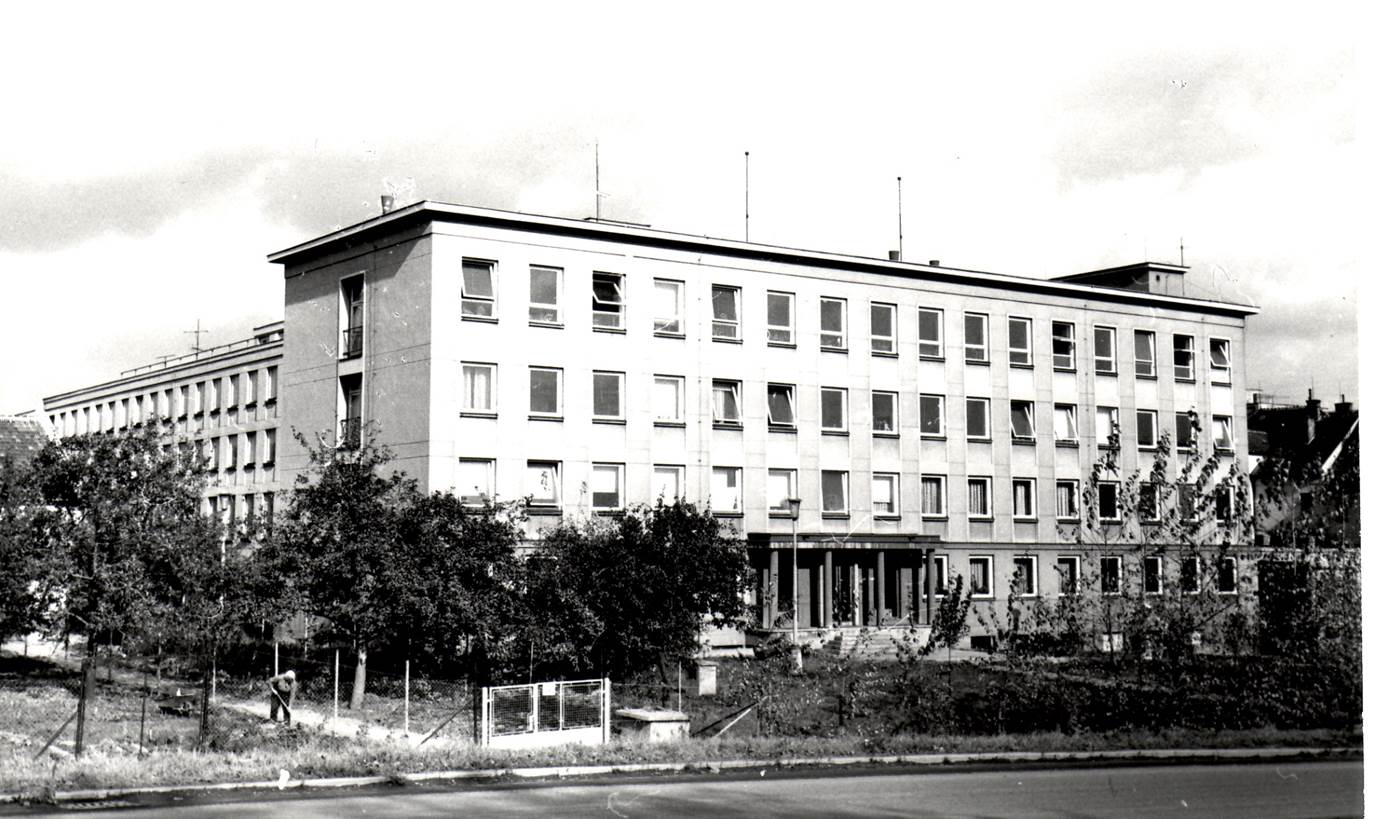 |
ISI History The Institute of Scientific Instruments (ISI) was established in 1957 as an institution providing instrumental equipment for other institutes of the Academy of Sciences in many areas. In the beginning the institute had 83 employees, though this number gradually increased to 240. During the process of transformation of the Academy of Sciences, which began in 1989, only the most promising branches of scientific research were supported at the institute. Consequently, the number of employees was reduced to 95 working full time. The structure of the scientific departments of the institute was also changed, so that it gained from the research activities of the projects solved by the research teams. The teams dealing with related problems are organised into departments. |
|
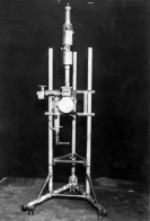 |
"Tripod" (1950) |
The Department of Electron Optics The history of electron optics (ELO) at the Institute of Scientific Instruments was shaped by personalities, whose scientific career had begun during their studies. The students of Prof. A. Bláha – A. Delong, V. Drahoš and L. Zobač – built the first prototype electron microscope in this country, and followed this with the first serially produced instrument (the BS 241). At that time electron microscopes were built in only three countries in the world. In 1954 a functional model of a desktop electron microscope (the Tesla BS 242) was built and it won the Gold Medal at EXPO 1958. Over 1000 of these instruments were produced over a period of 20 years and exported to 20 countries. |
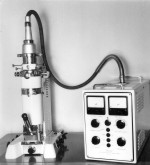 |
In 1950 the idea for a tabletop electron microscope was born, i.e. an instrument that would not aspire to ultimate parameters, and that would be simple, cheap and easy to operate. The instrument was completed in the Electron Optics Laboratory of the Czechoslovak Academy of Sciences, where six employees worked under the leadership of A. Delong. A number of these microscopes were produced in the developmental workshops of the CSAS, and serial production began in 1956 at Tesla Brno under serial number Tesla BS242. The instrument won a Gold Medal at the Expo 58 World Exhibition in Brussels. Tesla produced more than 1,000 of these microscopes over the following 20 years. The resolution of this microscope, already with astigmatism correction, was 5 nm, and with careful operation as little as 2 nm. The accelerating voltage was from 30 to 75 kV. The Tesla BS242 tabletop electron microscope (1954)
|
|
 |
The electron beam welder allowed the welding of ultrahigh vacuum parts of microscopes developed at the Institute of Scientific Instruments. According to documents from the ISI the welder was built by a number of institutions. Electron beam welder ES-2 (1969) |
|
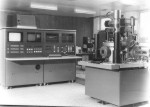 |
The electron beam lithograph contained a number of original solutions: a Schottky gun with high brightness, precise beam deflection, laser controlled motions of the specimen stage, and fast-response electronics. Electron beam lithograph (1985) |
|
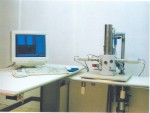 |
The first environmental scanning electron microscope in the Czech Republic for observing samples in their natural state (1996) | |
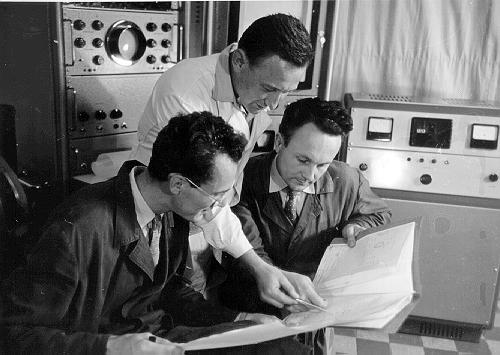 |
Ing. Josef Dadok (right), Ing. Oldrich Chramosta (left), and the technician R. Pospisil (middle). Ing. Josef Dadok - the founder and leading spirit of the early NMR at the Institute and in Czechoslovakia ... |
The Department of Nuclear Magnetic Resonance The Nuclear Magnetic Resonance (NMR) Department at ISI was founded in 1960 by J. Dadok, the constructor of the first ISI spectrometer working at a frequency of 30 MHz. The industrial production of spectrometers at TESLA Brno began in 1966. This was the only production of its kind in any of the Eastern European countries and continued for 25 years. These spectrometers were an extremely successful export article and several hundred of various types were produced, based on the R&D provided by ISI. |
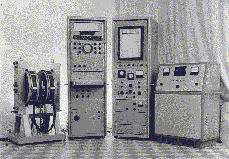 |
The second CW-NMR Spectrometer developed at the Institute of Scientific Instruments ... (1961) |
|
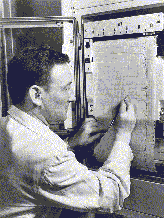 |
A CW-NMR spectrum produced by the historical 60 MHz instrument ...and the technician R. Pospisil (1964 - 1965) |
|
 |
CW NMR Spectrometer 80 MHz That time, a bit more freedom was in the air, and Ing. Dadok, CSc., left for a visiting fellowship in the USA in the fall '67 ... Later he become the Professor at Mellon Carnegie University in Pittsburgh, USA. (1967) |
|
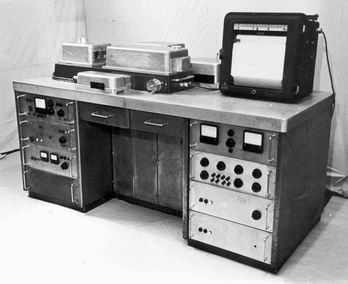 |
Single-beam infra-red spectrophotometer (1955) |
The Department of Coherence Optics The Department of Coherence Optics (former Quantum Generators of Light) was founded on the basis of the former Section of Infrared Spectroscopy at ISI shortly after the invention of lasers. F. Petrů was its head until 1999. At the beginning of 1960s the department was focused on the field of infrared spectrophotometry. From March 1963 the department had started work on manufacturing the first lasers in both solid and gaseous states. The department's staff was successful in both directions. Results came extremely quickly, as no longer than six months after this work began in October 1963 a stimulated emission at a wavelength of 1.15 μm was recorded, and shortly afterwards emissions at 3.39 µm and 633 nm obtained. An He-Ne laser working at a wavelength of 633 nm had already existed for two years and the technology of its production had not been published at that time. After being quickly put into production three types of lasers of different powers were displayed at the Brno Trade Fair in 1964 by their producer Meopta Přerov. A pulse laser was put into operation in 1964 and a machine for drilling diamonds was developed on its basis. Since 1967 the exact measurement of geometrical quantities by means of interference methods has been the main focus of the department. A frequency stabilized single-mode He-Ne laser was developed and formed the basis for the Czechoslovak laser sub-normal of lengths which was used by the metrological institutions of this country in the 1970s. Another achievement was the compact transferable and modular interferometric system (LIMS) that was designed for mechanical engineering and had several new functional possibilities –length measurement up to three axes, measurement of speeds, flatness, small angles with the possibility of correction to the air refractive index. In 1981 – 1982 a precise laser interferometric system was constructed. It measured the position in two coordinates with an accuracy of 40 nm as well as speed. From 1984 the department focused on the development of He-Ne lasers stabilized by the use of saturated absorption in iodine vapours, increasing the accuracy of interferometric systems, two-colour and absolute interferometry. |
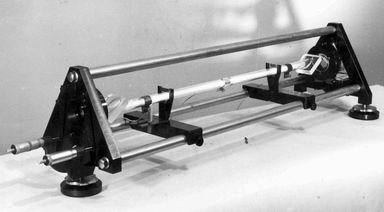 |
First Czechoslovak gas laser (October 1963) |
|
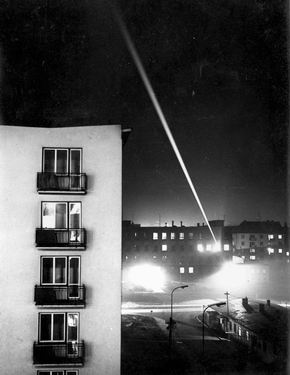 |
Years 1965 and 1966 were devoted to work on gas lasers with higher output power. | |
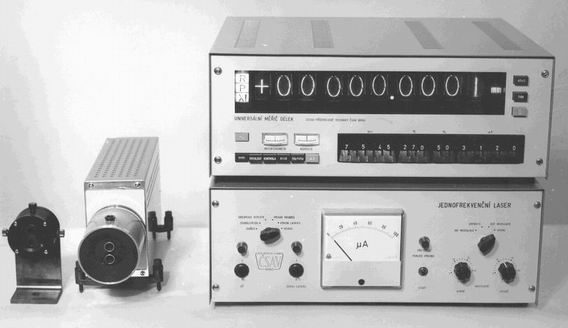 |
The first model of the universal length measuring system. The core of the system was supplemented by other units as a printer, x-y plotter and an automatic correction unit for the compensation of the refractive index of air. The company Metra Blansko included the system into their production line as a complex equipment for laboratories of industrial metrology in mechanical engineering. |
|
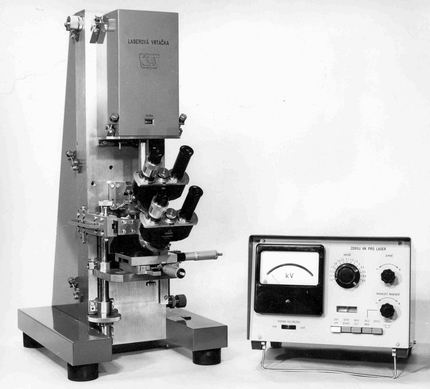 |
Laser drill for diamond feedtroughs. |











